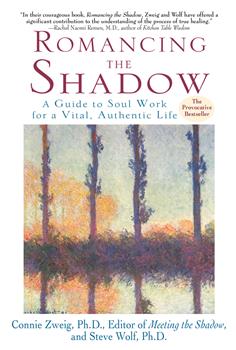Dr. Connie Zweig is a retired Jungian-oriented psychotherapist, author, and climate activist. Her professional work has focused on helping people meet, accept, and integrate their “shadows” — the parts of ourselves that we don’t want to look at. She holds a doctorate in Depth Psychology and has led seminars nationwide on meditation, spirituality, religious disillusionment and “shadow work.” She is co-author of Meeting the Shadow and Romancing the Shadow, and author of To Be A Woman, Meeting the Shadow of Spirituality, and the novel A Moth to the Flame: The Life Story of Sufi Poet Rumi.
In this book, “Romancing the Shadow: A Guide to Soul Work for a Vital, Authentic Life”, she elucidates the Shadow in a straightforward language. I personally found this book very helpful and reading it increased my intention to observe myself, my emotions, my actions, and reactions more closely on a daily basis.
Zweig and her co-author Wolf examine the Shadow, probably the least understood aspect of our psyche. The Shadow contains irrational desires and impulses, forbidden feelings based on our conditioning, and even unchanneled creative urges. Rather than repress and vilify the Shadow, the authors encourage us to embrace the Shadow as a mystery that can illuminate the hidden aspects of the self. By bringing forth those hidden aspects and continuously making a conscious relationship with the elusive unconscious we learn how to personify these aspects of ourselves into specific, concrete figures that we can see, hear, and feel within us. In that way, it becomes much easier to make the unconscious conscious — to bring them into awareness, recognize them when they erupt, and make a conscious relationship to them, so that they lose their grip over us. Just like Carl Jung, who stated “Everything that irritates us about others can lead us to an understanding of ourselves”.
It is not an easy read and it takes time to get through it. I personally appreciated that this book is filled with explanatory examples from mythology and interesting cases from the author’s therapeutic practices. In addition, the authors explore the manifestation of Shadow in all areas of life – work, family, friendship, love and even mid-life concerns.
They dedicate some time to the “Third Body”, which the authors interpret as “The Soul of a Relationship”. When we fall in love, we present ourselves as certain personas but the Shadow of each partner remains hidden. The authors provide specific examples in this book, explaining that couples who seem compatible may disguise conflicting values, their refined lifestyle may cover up financial problems, their “holy” behavior might hide Shadows that act out in sexual affair and so on. Or partners don’t think they can be vulnerable or angry, in other words, they are never ever authentic. But every relationship has a chance, if the couple stops “shadowboxing” – projecting of repressed anger -, and begins to “shadow-dance” with the loved one, whereby the authenticity between the partners deepens which leads to the presence of a “Third Body”. This is a new entity that is greater than the two separate individuals and if nurtured their love grows.
